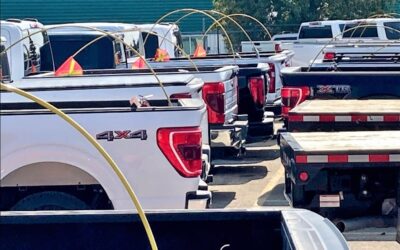Hazmat Regulations for Fleets
There are many considerations truck fleets need to make when managing operational aspects of the company. One of the most important things that they need to focus on is compliance and safety while operating the fleet. While the Electronic Logging Devices may be one of the most dominant concerns regarding safety and compliance, there are other regulations that fleet managers need to take into consideration as well. Among those, is DOT hazmat regulations.
There are many DOT hazmat regulations that apply to the fleet industry and it is important for you to know about them. Here is a look at what you need to know when it comes to the hazmat regulations for fleets.
When Are DOT Hazmat Regulations Applicable In Fleets?
The Pipeline and Hazardous Materials Safety Administration’s hazardous material regulations are applicable to fleets that are responsible for interstate, foreign and even intrastate transportation of goods that are hazardous. It applies in all the cases of transportation be it through sea, railways, aircrafts or motor vehicles.
Anybody who is considered to be a hazmat employee needs to go through specialized training regarding these regulations after every three years. They might be required to go through the training if the nature of the role they play at the company changes that might need them to get more DOT hazmat training.
Drivers that are going to be transporting hazardous materials are also required to take the training necessary to handle the hazardous materials. This means that anybody who is loading, unloading or even handling the hazardous materials needs to be aware of the DOT hazmat regulations.
- There’s More To ‘Hazardous Materials’ Than You Would Assume
In order to understand the DOT hazmat regulations, you need to know what is considered hazardous material. There are many fleets that transport pesticides, herbicides and other chemicals. These chemicals may not fall under the umbrella of hazardous materials, but it is important to note that there are everyday materials that do fall under that category. The list includes acids, bleaches, paints and even make-up.
- DOT Hazmat Regulations Don’t Cover All Hazardous Materials
There are certain items which can be considered hazardous, but the DOT hazmat regulations do not apply to them. The Materials of Trade exception refers to objects other than hazardous waste that can be carried by a motor vehicle that protects the safety and health of the operator.
There are also exceptions to the DOT hazmat regulations when the hazardous material being transported is in a very limited quantity.
- Top DOT Hazmat Violations
These are the top 5 violations regarding DOT Hazmat regulations.
- The package being transported is not properly secured.
- There is no copy of the DOT Hazmat Registration number.
- There is a problem with the shipping paper accessibility.
- The shipping papers are not in order.
- The placard has been damaged, obscured or it has deteriorated.
4. Make Sure Training Covers Everything
The employee training for DOT hazmat regulations needs to cover a few crucial topics:
- Safety training. This includes the most basic emergency response processes.
- Security training which will encompass the risks involved with handling and transporting the hazardous materials.
- Awareness of the regulations. This also includes understanding why there is a need for the regulations as well.
- Function-specific training. This should cover the specific things that a person needs to know based on the role the employee has to play.
All the new employees for fleets are required to complete the DOT hazmat training before they can take on a task that has anything to do with hazardous materials. They can only perform the functions of the job once they have completed the necessary training. This is also going to be done only when they are under supervision from someone who has already had extensive training and experience.
The Department of Transportation and the hazmat regulations have not specified where the training needs to be done from. There are also no courses being offered in schools or any training camps that are certified to train for hazmat regulations. This is why it falls on the employer to make sure that the regulations are followed. It also means that the employer or the fleet manager must make sure the employees get the proper DOT hazmat training under more experienced professionals. The course of action required can include anything from self-paced instructions, interactive videos or lectures.
5. Certain Regulations Vary Based On Location
There are companies that have trucks transporting hazardous materials which are located across different states. Every state has its own set of laws concerning DOT hazmat regulations. This means that the state laws define their own regulations when it comes to hazmat vehicles, the routes that they can take and the roads that they should be given access to. The FMCSA website has a list of all the records and they make it a point to update it regularly to keep the most current information for them to refer to.
6. Changes in Regulations Take Place – Be Attentive
The requirement for fleets to conduct the training for their employees is three years but they should also make it a point to keep up with any changes made to the DOT hazmat regulations if and when they happen. The employers and fleet managers are required to pay attention to the changes when they are announced. Staying informed is more of a responsibility for the fleet manager and the employers. Whenever an update comes out, the fleet managers and employers have to update their employees based on who is affected. You might not need to immediately change the company policy until the next round of training but it is important to notify every employee affected as soon as you can. This will prepare them for when the next training comes around.
7. Stay Up to Date with Changing Regulations
With each new presidency, changes can be made to DOT Hazmat regulations which is why it is important to stay up to date on any possible changes. Policies are often updated in each administration to better reflect directives from the federal government in keeping workers safe from hazardous materials.
Now that you understand how DOT hazmat regulations apply to fleets, learn the benefits to renting fleets.






